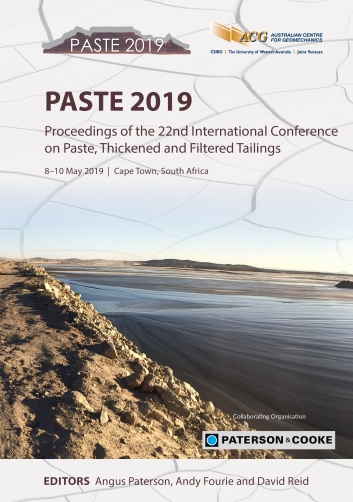Earth observation data and satellite InSAR for the remote monitoring of tailings storage facilities: a case study of Cadia Mine, Australia

|
Authors: Thomas, A; Edwards, SJ; Engels, J; McCormack, H; Hopkins, V; Holley, R |
DOI https://doi.org/10.36487/ACG_rep/1910_11_Thomas
Cite As:
Thomas, A, Edwards, SJ, Engels, J, McCormack, H, Hopkins, V & Holley, R 2019, 'Earth observation data and satellite InSAR for the remote monitoring of tailings storage facilities: a case study of Cadia Mine, Australia', in AJC Paterson, AB Fourie & D Reid (eds), Paste 2019: Proceedings of the 22nd International Conference on Paste, Thickened and Filtered Tailings, Australian Centre for Geomechanics, Perth, pp. 183-195, https://doi.org/10.36487/ACG_rep/1910_11_Thomas
Abstract:
Tailings storage facilities (TSFs) are an essential infrastructure of mineral processing, but they represent a significant physical, chemical and biological hazard and must, therefore, be strictly and responsibly sited, managed and closed. Tailings can, for example, be dispersed by many processes (such as sinkholes, earthquakes, intense rainfall and flood events, and wind), substandard design and construction, and seepage. The stability and behaviour of TSFs needs to be continuously monitored and one highly effective way of doing this is through satellite Earth observation (EO). The EO industry is witnessing a technological revolution. Large and long-lifespan satellite sensors that have been the staple of national space agencies and commercial satellite manufacturers are now being complemented by constellations of low-cost, short-lifespan ‘cube sats’ by companies with the ambition to image the whole earth daily. Satellites with synthetic aperture radar (SAR) sensors are also collecting high volumes of data, with the added benefit of being able to do so day or night and in different weather conditions. The range of data options and capabilities these provide open opportunities for novel data analysis techniques for TSFs. One of these is satellite InSAR (interferometric SAR; a technique used to map millimetric-precision changes in ground height over time), which is already used by mining companies to reduce risk in and of their operations. From monitoring the stability of TSFs, through to assessments of impacts of natural hazards, InSAR allows rapid and accurate targeting of high-risk areas and structures to identify those that require subsequent investigation through ground-based methods. To demonstrate the application of EO data and InSAR in identifying pre- and post-failure mine activities and TSF deformation, the authors will present a case study across Cadia mine, New South Wales, Australia, which had a localised TSF failure on 9 March 2018. The InSAR results presented show that low-magnitude subsidence signals were observed across the TSF dam during the year preceding the collapse. In January 2018 a notable change in behaviour was observed, with a concentrated area of subsidence focused on the region which initially failed on 9 March 2018. Furthermore, post-collapse InSAR measurements show an increased rate of subsidence for regions either side of the failure zone. Review of medium- and high-resolution satellite images show that the failure was phased, with an initial failure and then a subsequent failure at least two days after 9 March 2018. It also highlights what might be construction activity associated with a dam raise prior to failure.
Keywords: tailings, TSF, InSAR, satellite, slope stability, displacement, earth observation
References:
Carlà, T, Intrieri, E, Di Traglia, F, Nolesini, T, Gigli, G & Casagli, N 2017, ‘Guidelines on the use of inverse velocity method as a tool for setting alarm thresholds and forecasting landslides and structure collapses’, Landslides, vol. 14, no. 2, pp. 517‒534.
Commonwealth of Australia 2016, Tailings Management, Leading Practice Sustainable Development Program for the Mining Industry Handbook Series, Australian Government.
Kossoff, D, Dubbin, WE, Alfredsson, M, Edwards, SJ, Macklin, MG & Hudson-Edwards, KA 2014, ‘Mine tailings dams: characteristics, failure, environmental impacts, and remediation’, Applied Geochemistry, vol. 51, pp. 229‒245,
Lottermoser, B 2007, Mine Wastes: Characterization, Treatment and Environmental Impacts, Springer-Verlag, Heidelberg.
Martin, TE & Davies, MP 2000, ‘Trends in the stewardship of tailings dams’, Proceedings of the Seventh International Conference on Tailings and Mine Waste, A.A. Balkema, Rotterdam, pp. 393–407.
Rico, M, Benito, G, Salgueiro, AR, Díez-Herrero, A & Pereira, HG 2008, ‘Reported tailings dam failures: a review of the European incidents in the worldwide context’, Journal of Hazardous Materials, vol. 152, pp. 846‒852.
Vick, SG 1983, Planning, Design, and Analysis of Tailings Dams, John Wiley & Sons, New York.
© Copyright 2025, Australian Centre for Geomechanics (ACG), The University of Western Australia. All rights reserved.
View copyright/legal information
Please direct any queries or error reports to repository-acg@uwa.edu.au
View copyright/legal information
Please direct any queries or error reports to repository-acg@uwa.edu.au


